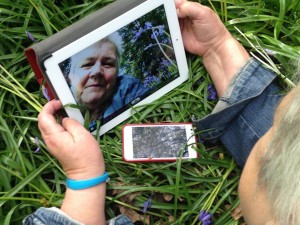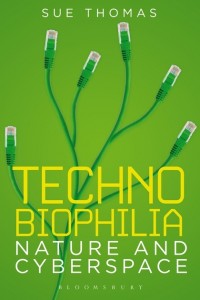Futurefest with “some of the planet’s most radical thinkers, makers and performers” is taking place in London next weekend on Sept. 28 – 29, 2013 and I am very pleased to be featuring an interview with one of Futurefest’s speakers, Sue Thomas who amongst many other accomplishments was also the founder of the Creative Writing and New Media programme at De Montfort University, UK, where I got my master’s degree.
Here’s Sue,
Sue Thomas was formerly Professor of New Media at De Montfort University. Now she writes and consults on digital well-being. Her new book ‘Technobiophilia: nature and cyberspace’ explains how contact with the natural world can help soothe our connected lives.http://www.suethomas.net @suethomas
- I understand you are participating in Futurefest’s SciFi Writers’ Parliament; could you explain what that is and what the nature of your participation will be?
The premise of the session is to invite Science Fiction writers to play with the idea that they have been given the power to realise the kinds of new societies and cultures they imagine in their books. Each of us will present a brief proposal for the audience to vote on. The panel will be chaired by Robin Ince, a well-known comedian, broadcaster, and science enthusiast. The presenters are Cory Doctorow, Pat Cadigan, Ken MacLeod, Charles Stross, Roz Kaveney and myself.
- Do you have expectations for who will be attending ‘Parliament’ and will they be participating as well as watching?
I’m expecting the audience for FutureFest http://www.futurefest.org/ to be people interested in future forecasting across the four themes of the event: Well-becoming, In the imaginarium, We are all gardeners now, and The value of everything. There are plenty of opportunities for them to participate, not just in discussing and voting in panels like ours, but also in The Daily Future, a Twitter game, and Playify, which will run around and across the weekend.
- How are you preparing for ‘Parliament’?
I will propose A Global Environmental Protection Act for Cyberspace The full text of the proposal is on my blog here http://suethomasnet.wordpress.com/2013/09/05/futurefest/ It’s based on the thinking and research around my new book Technobiophilia: nature and cyberspace http://suethomasnet.wordpress.com/technobiophilia/ which coincidentally comes out in the UK two days before FutureFest. In the runup to the event I’ll also be gathering peoples’ views and refining my thoughts.
The whole of FutureFest looks great and I’m excited about being there all weekend to enjoy it. The following week I’m doing a much smaller but equally interesting event at my local Cafe Scientifique, which is celebrating its first birthday with a talk from me about Technobiophilia. I’ve only recently moved to Bournemouth so this will be a great chance to meet the kinds of interesting local people who come to Cafe Scientifique in all parts of the world. http://suethomasnet.wordpress.com/2013/09/12/cafe-scientifique/
I’ll also be launching the book in North America with an online lecture in the Metaliteracy MOOC at SUNY Empire State University. The details are yet to be released but it’s booked for 18 November. http://metaliteracy.cdlprojects.com/index.html
- Is there anything you’d like to add?
I’m also doing another event at FutureFest which might be of interest, especially to people interested in the future of death. It’s called xHumed and this is what it’s about: If we can archive and store our personal data, media, DNA and brain patterns, the question of whether we can bring back the dead is almost redundant. The right question is should we? It is the year 2050AD and great thought leaders from history have been “xHumed”. What could possibly go wrong? Through an interactive performance Five10Twelve will provoke and encourage the audience to consider the implications via soundbites and insights from eminent experts – both living and dead. I’m expecting some lively debate!
Thank you, Sue for bringing Futurefest to life and congratulations on your new book!
You can find out more about Futurefest and its speakers here at the Futurefest website. I found Futurefest’s ticket webpage (which is associated with the National Theatre) a little more informative about the event as a whole,
Some of the planet’s most radical thinkers, makers and performers are gathering in East London this September to create an immersive experience of what the world will feel like over the next few decades.
From the bright and uplifting to the dark and dystopian, FutureFest will present a weekend of compelling talks, cutting-edge shows, and interactive performances that will inspire and challenge you to change the future.
Enter the wormhole in Shoreditch Town Hall on the weekend of 28 and 29 September 2013 and experience the next phase of being human.
FutureFest is split into four sessions, Saturday Morning, Saturday Afternoon, Sunday Morning and Sunday Afternoon. You can choose to come to one, two, three or all sessions. They all have a different flavour, but each one will immerse you deep in the future.
Please note that FutureFest is a living, breathing festival so sessions are subject to change. We’ll keep you up to date on our FutureFest website.
Saturday Morning will feature The Blind Giant author Nick Harkaway, bionic man Bertolt Meyer and techno-cellist Peter Gregson. There will also be secret agents, villages of the future and a crowd-sourced experiment in futurology with some dead futurists.
Saturday Afternoon has forecaster Tamar Kasriel helping to futurescape your life, and gamemaker Alex Fleetwood showing us what life will be like in the Gameful century. We’ve got top political scientists David Runciman and Diane Coyle exploring the future of democracy. There will also be a mass-deception experiment, more secret agents and a look forward to what the weather will be like in 2100.
Sunday Morning sees Sermons of the Future. Taking the pulpit will be Wikipedia’s Jimmy Wales, social entrepreneur and model Lily Cole, and Astronomer Royal Martin Rees. Meanwhile the comedian Robin Ince will be chairing a Science Fiction Parliament with top SF authors, Roberto Unger will be analysing the future of religion and one of the world’s top chefs, Andoni Aduriz, will be exploring how food will make us feel in the future.
Sunday Afternoon will feature a futuristic take on the Sunday lunch, with food futurologist Morgaine Gaye inviting you for lunch in the Gastrodome with insects and 3D meat print-outs on the menu. Smari McCarthy, founder of Iceland’s Pirate Party and Wikileaks worker, will be exploring life in a digitised world, and Charlie Leadbeater, Diane Coyle and Mark Stevenson will be imagining cities and states of the future.
I noticed that a few Futurefest speakers have been featured here:
Eric Drexler, ‘Mr. Nano’, was last mentioned in a May 6, 2013 posting about a talk he was giving in Seattle, Washington to promote his new book, Radical Abundance.
Martin Rees, Emeritus Professor of Cosmology and Astrophysics, was mentioned in a Nov. 26, 3012 posting about the Cambridge Project for Existential Risk (humans relative to robots).
Bertolt Meyer, a young researcher from Zurich University and a lifelong user of prosthetic technology, in a Jan. 30, 2013 posting about building a bionic man.
Cory Doctorow, a science fiction writer, who ran afoul of James Moore, then Minister of Canadian Heritage and now Minister of Industry Canada, who accused him of being a ‘radical extremists’ prior to new copyright legislation for Canadians, was mentioned in a June 25, 2010 posting.
Wish I could be at London’s Futurefest in lieu of that I will wish the organizers and participants all the best.
* On a purely cosmetic note, on Dec. 5, 2013, I changed the paragraph format in the responses.


![Richard Walker (left), chief roboticist, and Dr Bertolt Meyer (right) at the Body Lab. On the table is an iWalk BiOM ankle. Photograph: Channel 4 [downloaded from http://www.guardian.co.uk/science/blog/2013/jan/30/build-bionic-man]](http://www.frogheart.ca/wp-content/uploads/2013/01/Bionic-man-Meyer-Walker.jpg)
![A television company asked Dr Bertolt Meyer – who has a prosthetic arm – to rebuild himself in bionic form. Photograph: Channel 4 [downloaded from http://www.guardian.co.uk/science/blog/2013/jan/30/build-bionic-man]](http://www.frogheart.ca/wp-content/uploads/2013/01/Bionic-man-Rex.jpg)